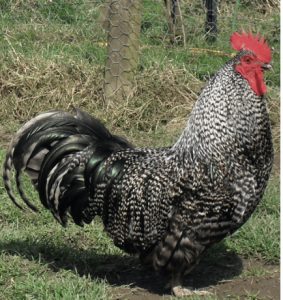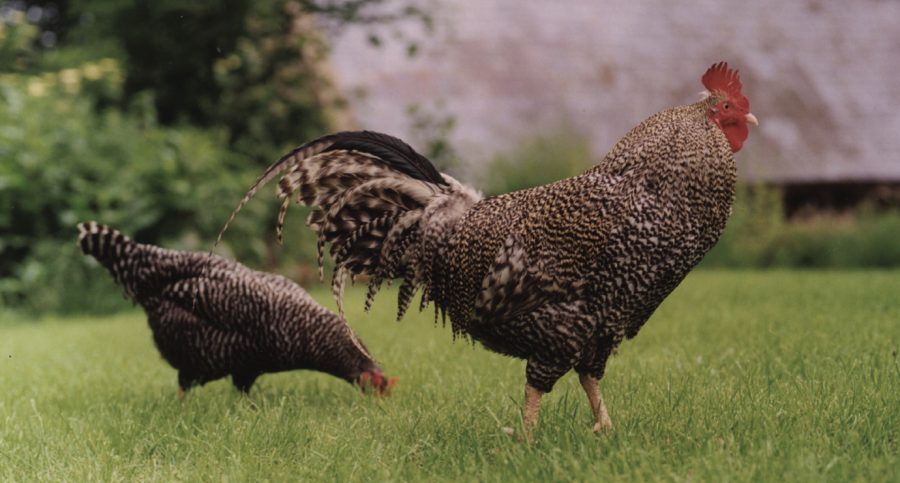Tom Blunt, Senior Conservation Adviser at the Rare Breeds Survival Trust, looks at the remarkable heritage of two iconic Scottish chicken breeds – and their place today…
The two chicken breeds most closely associated with Scotland are both categorised as Priority Breeds on the current RBST Watchlist. Having become very rare over the course of the twentieth century, the Scots Grey and Scots Dumpy are both rare breeds with unique genetic and cultural value that would be simply irreplaceable if either were to die out.
BREED HERITAGE
The Scots Grey is often described as the traditional old breed of Scotland. Detailed documentation about them is scarce but Victorian poultry books agree that the Scots Grey goes back to the 16th Century. Known primarily as a cottager’s or crofter’s fowl, the Scots Grey has long been known for its hardiness, excellent foraging ability and capacity to thrive in cold and damp conditions.
As for Scots Dumpies, legend has it that when the Roman Army moved north of the border, the Picts carried a type of poultry similar to today’s Dumpies to warn off strangers approaching the camp. The Scots Dumpy is first mentioned as a breed in the 1850s and by the early twentieth century it was known by many different names such as ‘Creepies’ ’Crawlers’ and ‘Bakies’. With breed numbers very low in the 1970s, the Domestic Fowl Trust managed to track down a flock in Kenya whose ancestors had travelled there with Lady Violet Carnegie in 1902 as part of her dowry. The Trust arranged for the importation of 12 birds from this flock back into the UK in 1977, which helped re-invigorate the breed in Scotland.

Scots Dumpy Cock
BREED CHARACTERISTICS
The Scots Grey is classed as a non-sitter, but if chicks are hatched then it is a good mother. They can become quite tame if handled regularly. The breed is a good all-round layer of whitish eggs, its breast meat is not over generous but it is particularly full of flavour, with good texture and whiteness of skin. They taste rather like partridge.
The precise barring of the Scots Grey’s feathers results in a beautifully smart and crisp looking bird. The breed has white beak and legs with black mottles or streaks, a single upright comb and red earlobes.
Scots Dumpies are good layers, and they are considered particularly good as broodies. The breed is known for its short-legged gene which means that a percentage of chicks have short legs, a percentage have long legs, and some do not hatch. Dumpies are best kept on easy terrain, and the chicks should be kept separate from more vigorous breeds when rearing. Chicks should not be let onto long wet grass too early as they chill easily, otherwise they are perfectly hardy.
A variety of colours can be seen in the Scots Dumpy breed. The black Scots Dumpy is all black with a beautiful green metallic sheen, dark eyes, dark beak, dark legs with four toes, a single comb and red ear lobes. In the cuckoo colour, the background is grey with darker grey stripes all over and white or lightly mottled legs. Blue and white colour variations can also be found. A Scots Dumpy’s legs must not exceed 3.75 cm.
SUPPORTING THE BREEDS
Rare breeds such as the Scots Grey and the Scots Dumpy can only survive thanks to the people who choose to keep them. Some of our rarest poultry breeds still exist today due to just a handful of people seeing them through the times when their numbers have been perilously low. We are
in a challenging time for rare poultry and each individual who supports these breeds now can make a crucial difference to safeguarding their genetic diversity and protecting a living heritage for the future.
If you don’t breed poultry but keep a group of chickens for eggs, by choosing a rare breed you are still helping create a market for those who do breed them.
Anyone interested in keeping these rare breeds can visit the poultry pages of RBST’s website at www.rbst.org.uk/rare-breed-chickens for information and support in getting started including choosing your chickens, basic health care, feeding and watering, housing your chickens, and rules and regulations, as well as links to the relevant breed societies.
Main image: Scots Grey Cock & Hen (Credit RBST-Simon Tupper)
To receive regular copies of The Country Smallholder magazine featuring more articles like this, subscribe here.
For FREE updates from the world of smallholding, sign up for The Country Smallholder newsletter here.








